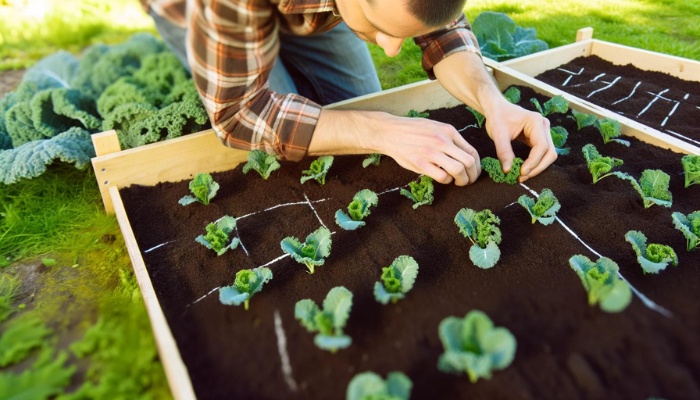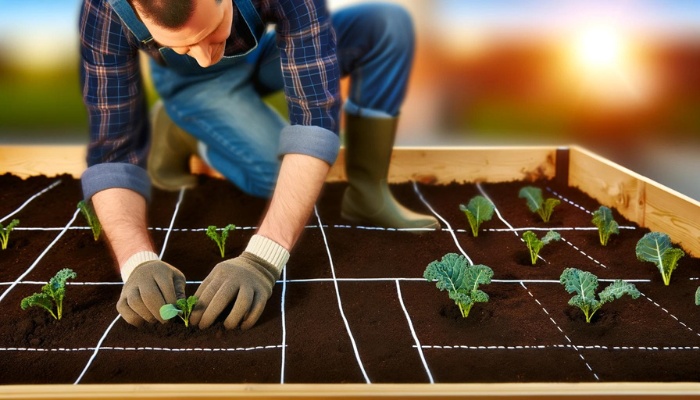Kale, a powerhouse of nutrients and a staple in health-conscious kitchens, thrives remarkably well in the compact, efficient layout of a square foot garden.
This gardening method, celebrated for its ability to maximize productivity in minimal space, is an excellent match for kale’s robust growth habits and minimal space requirements.
Whether you’re a seasoned gardener or new to the green world, square foot gardening offers a structured, accessible approach to cultivating your own lush, leafy greens.
Planning Your Garden Layout
When planning your garden layout for kale square foot gardening, consider the specific spatial requirements and optimal growing conditions of kale to maximize yield and efficiency.
Kale thrives under full sun exposure, necessitating a minimum of 6 to 8 hours of sunlight daily. Positioning your kale plants in areas where they can receive ample sunlight is fundamental.
However, in regions with harsh summer heat, partial shade can prevent bolting and bitterness, optimizing growth conditions.
Companion planting plays a pivotal role in the health and productivity of your kale. Integrating plants such as garlic, onions, or herbs nearby can deter pests naturally, enhancing your kale’s growth environment without the need for chemical interventions.
This strategy not only conserves space within your square foot garden but also promotes a biodiverse ecosystem that supports the overall health of your plants.
It’s essential to allocate one square foot per kale plant within your layout to ensure each has adequate space to grow without competition for resources.
This spacing maximizes air circulation, reducing the risk of fungal diseases and fostering a more robust, productive garden.
Soil Preparation and Fertilization
To ensure optimal growth for your kale in square foot gardening, it’s important to focus on soil preparation and fertilization, tailoring these elements to meet the specific nutrient demands of this leafy green.
Kale thrives in well-aerated, nutrient-rich soil with a pH range of 6.0 to 7.5, making pH testing an essential first step. This initial analysis guides the amendment process, ensuring the soil environment is conducive to kale development.
- pH Testing: Utilize a soil pH test kit to determine the current state of your garden’s soil. If the soil is too acidic (below 6.0), incorporating garden lime can help raise the pH. Conversely, if the soil is alkaline (above 7.5), sulfur amendments can help lower the pH to an optimal level.
- Compost Making: Enrich the soil by adding homemade compost. This organic matter boosts the soil’s fertility and structure, providing kale with essential nutrients like nitrogen, phosphorus, and potassium. Compost also improves soil drainage and water retention.
- Fertilization: After enriching the soil with compost, additional fertilization may be necessary during the growing season. A balanced, slow-release fertilizer ensures continuous nutrient availability for kale to support robust growth.
Planting and Spacing Guidelines

Properly spacing your kale plants within the square foot gardening framework is crucial for maximizing growth and yield.
When considering seed selection, choose varieties that are well-suited to your climate and the square foot gardening method.
This approach ensures that each kale plant receives adequate resources without competition, promoting healthier growth and more robust yields.
Pre-germinating your seeds can significantly increase the success rate of your kale crop. This involves soaking the seeds for a brief period to encourage sprouting before planting.
Once germinated, planting your kale seeds or seedlings at the correct spacing is critical.
- For full-size kale plants, plant one kale seedling per square foot.
- If you prefer smaller plants for baby kale, plant up to eight plants per square foot.
Watering and Maintenance Tips
The correct approach to watering and maintenance not only supports the plant’s health but also maximizes yield and improves the quality of the leaves.
Here are three critical aspects to consider:
- Watering Frequency and Depth: Kale requires consistent moisture to thrive, especially during the initial stages of growth and during dry spells. It’s recommended to water deeply at least once a week, delivering about an inch of water. This method encourages deeper root development, enhancing the plant’s drought resistance.
- Mulching Techniques: Applying a layer of organic mulch around your kale can significantly improve moisture retention, suppress weeds, and regulate soil temperature. Opt for straw, shredded leaves, or grass clippings as mulch materials. This practice not only conserves water but also adds nutrients to the soil as the mulch decomposes.
- Harvest Methods: Begin harvesting when leaves are about the size of your hand. Cutting the outer leaves first allows the center to continue growing, promoting a continuous yield. This selective harvest method encourages the plant to produce new leaves, extending the harvest season.
Implementing these detailed, analytical strategies ensures your kale garden is both productive and sustainable.
Managing Pests and Diseases
Combatting pests and diseases in your kale garden requires a vigilant, informed approach to maintain plant health and ensure bountiful harvests.
One effective strategy is the use of biological control, which involves introducing natural predators of kale pests into your garden.
This method is advantageous for its sustainability and for reducing reliance on chemical pesticides, which can harm beneficial organisms and lead to resistance in pest populations.
Ladybugs, for instance, can be introduced to prey on aphids, a common kale pest.
In addition to biological control, implementing crop rotation is crucial for managing diseases in a square foot gardening setup.
This practice involves changing the location of your kale crops each year to prevent the buildup of soil-borne pathogens and pests that can overwinter and attack the next season’s plants.
By rotating your kale with unrelated crops, you effectively break the life cycle of many pests and diseases, thus safeguarding your garden’s health.
These strategies require careful planning and observation but are integral to maintaining a productive and healthy kale garden.
By embracing biological control and crop rotation, you’re employing a scientific, detailed approach to pest and disease management that benefits your garden ecosystem.

